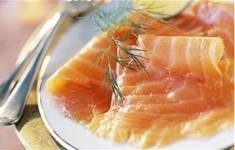 Oriental Ocean Scitech Co. last year introduced its salmon to the market at the terminal price of CNY 200 (USD 32, EUR 25) per kilogram, “but did not sell very well. Despite the high price…it is very troublesome to breed salmon,” the company said.
Oriental Ocean Scitech Co. last year introduced its salmon to the market at the terminal price of CNY 200 (USD 32, EUR 25) per kilogram, “but did not sell very well. Despite the high price…it is very troublesome to breed salmon,” the company said.Listed on the Shenzhen stock exchange, Shandong Oriental Ocean imported 200,000 salmon fish fries from Norway over the past two years and partnered with the Ocean Research Institute of the Chinese Academy of Science in a breeding program centered on Da Ji Jia town, near the port city and seafood processing hub of Yantai. In May 2012, Shandong Oriental Ocean started to sell live salmon to local retailers, “and received recognition from food and beverage sectors for the quality of the fish,” according to the firm. In September last year Oriental Ocean started to supply outlets Jusco supermarket (a subsidiary of Japan-based Aeon) with whole salmon selling for CNY 550 (USD 88, EUR68), and fresh salmon sashimi retailing for CNY 140 (USD 23, EUR 17) per 500 grams.
The company — which uses the logistics of its turbot cultivation program for its salmon breeding venture — until the end of 2012 cultivated 700 tons of salmon, according to Wang Shunkui, manager of the company’s breeding department. He believes the firm can ultimately produce 1,400 tons per year. “As the salmon system is now more and more stable, we assume that the production could become twice as much as before.”
Also watching the firm’s performance on the Shenzhen exchange, Shanghai-based Changjiang Securities meanwhile noted Oriental Ocean’s strategy of selling live salmon, at prices “a little bit higher” than imported Norwegian salmon. “But because of the retailers’ lack of necessary equipment, the sales of live salmon have been lower than expected. Now the company is finding solutions to promote live salmon sales. If this does not go smoothly, the company may sell salmon pieces instead.”
Salmon importers appear unperturbed at the local competition offered by Oriental Ocean. A senior Norwegian seafood executive, when speaking recently to SeafoodSource, pointed to rumors in 2012 which suggested that the sale of Oriental Ocean's live salmon business was poor. Speaking anonymously to Seafoodsource, a company spokesperson conceded “at first it was too troublesome to breed live salmon for the retail trade, since the water in the tanks must be changed eight times a day.” Likewise, he added, customers were at first skeptical. “Some of them doubted that manual-breeding of salmon would produce unnaturual fish.”
Yet the obstacles appear to have been overcome, at least judging by analysis of Oriental Ocean published by Qilu Securities in February which suggested Shandong Oriental Ocean’s sales of live salmon by the firm started to increase in January 2013 and pointed to new supply contracts signed with retailers in Shanghai and Guangzhou. Qilu Securities has estimated the company will sell 450 tons of salmon at CNY 90 (USD 14.5, EUR 11) per kilogram in 2013, which at a 40 percent net profit will net the firm CNY 17 million (USD 2.7 million, EUR 2 million) net profit. Salmon will thus become the main source of profit for Oriental Ocean, which has also sought to grow its cultivation space for sea cucumbers. Given supply and price remain stable, the firm’s performance in 2013 will be “beyond expectations,” said Qilu.
In filings of its preliminary 2012 earnings, Oriental Ocean reported sales of sea cucumber in 2012 totaling 1,000 tons, up 20 percent year-over-year, with average prices in 2012 of CNY 157 (USD 25 million, EUR 19 million) per kilogram — the average price in 2011 was CNY 200 (USD 32, EUR 25) per kilogram. Yet trading profits in 2012 were CNY 102 million (USD 16 million, EUR 13 million), increasing 4.05 percent year-over-year.
What Oriental Ocean certainly has on its side is connections. In 2012 the firm was named one of “the most valuable brands of Shandong” by the provincial government — an honor reserved for firms with solid ties to local officials. Aside from aquaculture, the company has interests in real estate and owns a private hospital and a kindergarten — demand for private medical care and education, like salmon, is strong among China’s growing middle class.





